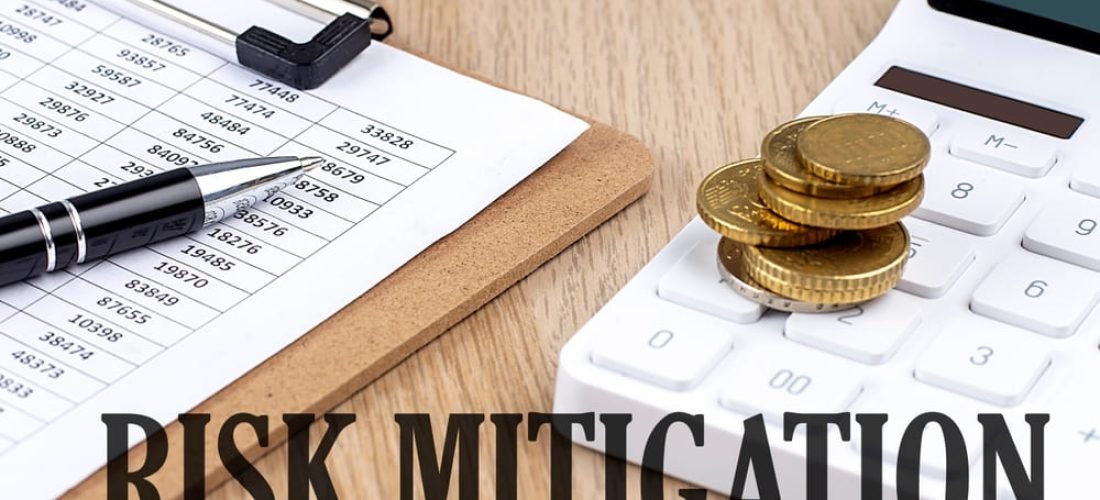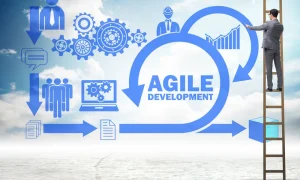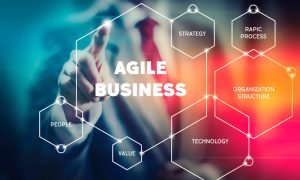Navigating the complexities of risk handling is essential for any business seeking to thrive in an unpredictable landscape, making risk management important in identifying and mitigating threats in a business environment. This guide strips away the complexity to provide clear, tactical steps for identifying, evaluating, and mitigating risks. You’ll learn to develop robust strategies tailored to various types of risks, from financial to strategic. By the end of this read, you’ll not only understand the essence of effective risk handling, but also be equipped with practical tools to turn potential threats into opportunities for resilience and growth.
Key Takeaways
- Risk handling is a methodical process integral to risk management, encompassing the identification, evaluation, selection, and implementation of strategies to control risks, which is not a one-time activity but a continuous cycle integral to an organization’s success.
- Effective risk management requires strategies tailored to specific types of risks such as financial, operational, and strategic risks, each necessitating a unique approach to mitigate their impact on organizational stability and growth.
- The implementation of risk handling techniques is an ongoing process that includes establishing a risk handling framework, integrating risk handling into decision making, and continuously monitoring and adjusting strategies in response to the evolving risk landscape.
Understanding Enterprise Risk Management Handling
Risk handling, which is also known as risk mitigation, is an organized process to be carried out by grasping the potential risks through identification, evaluation, and plans to implement appropriate strategies. When you provide this, it enables companies in identifying and averting probable risks in order to have secure travel to success.
Risk management is most of the case cyclical and the cycle typically consist of identifying, assessing the impact and managing the risks and finally monitoring the results. Risk identification is a pre-emptive strategy which could be brought down through the application of tools and control processes as well as quarterly risk assessments internally and externally.
It is paramount to journal down all risks identified, what would respond to those, and post-action notes in risk register or inventory. Every phase is essential, like a relay race where the baton is transferred, in case any stage is not completed successfully, then the project is at stake.
Visualize it as running a marathon, each step paying attention, and a real fight for the victory. The identical potent danger proposition is controlling the same which requires diligent effort by recognizing a favorable cause-effect analyzing outcomes evaluating consequences developing counter-propositions checking it’s effectiveness constantly, are key contributors to any successful endeavor, while understanding risks weigh heavily factor in during decision-making processes.
Shaping this into a sentence we will get: Which shows how Risk Handling (that is Mitigating Risks) is like a guiding force that leads the entrepreneurs’ ship (business) from stormy seas to calm harbors by working out of procedures within reliable framework, the sailor (the entrepreneur) starts with the area risk assessment, then determines severity levels and decide on the measures needed before embracing such procedures.
Key Components of Risk Handling
As with the gradual development of a house from its foundation and frame to its shingled walls, the creation of a risk-management plan should include its main components. Critical aspect of this process is a thorough understanding of risks that business might face, evaluating them, responding to them, and continuously monitoring how they affect business.
The first vital step of this management is hazard risk recognition through the pronounced warnings which help to identify the hazards through practical identification processes. Such a realization will involve awareness on causes behind the risks. Immediately, the process moves on to risks assessment, where anything that may produce negative consequences is evaluated. Chase the risk with two steps: revealing risks, which allows to choose strategy that solves them (risk response).
In addition to that, it should be taken into consideration to frequently check all the risks and their impact and also how well all the strategies are working, risk monitoring is an example of that.
This all-inclusive method—which provides defense mechanisms against various uncertainties and issues—is essential to the overall resiliency against potential barriers by the organization.
The Role of Risk Handling in Risk Management
Handling of risk is not the harmless sector of the risk management process, but the very essence of the whole undertaking. Crucially, it is a preventative measure that aids the management to avoid future loss of resources in the organization and in turn, help in strategic planning by providing answer on the questions of when and how accidents happen.
From risk assessment to risk mitigation, risk management starts with a risk identification. Each step of the process has the risk handling as an important element that allows business to keep operating safely.
Risk management is not only a strategy of mitigating risks but it also encourages growth and expansion and enhances stability and longevity. Converting seemingly inevitable risks into possibilities by thorough prevention and putting in action risk aversion measures can significantly cut down the risks’ damaging consequences and help the organization achieve the stability and success it needs.
Risk handling provides a way for managers to preemptively identify areas that pose problems by them integrating risks considerations into the strategic plan and providing a proactive mindset that helps in the planning and implementation of the risk mitigating strategies and creating awareness in the organizations of the risks.
Further Reading: Risk Management: Ultimate Guide to Navigating Uncertainties
Types of Risks and Appropriate Handling Strategies
A range of risks can be encountered in business, including financial risks, operational risks, and strategic risks. Financial risk appears to be an important factor on enterprise risk management because it comes straight to the heart of a company’s strategic and financially concerns. Companies must detect, distinguish and deal with the financial risks to ensure that they sufficiently fully effective respond to the consequences and challenges of the enterprise. This practice is definitive for the risk structure such as contracts and premiums. Additionally, it can be used for risk prediction and better allocation of resources.
Similarly to a tailor who designs a specific suit with great precision, the same has to happen in the process of configuring the appropriate strategies with such also specific risks. In this case, risk management entails greatly different strategy than handling any other risk related to operation, business strategy and so on. The principle of forming an appropriate strategy is rendering each type of threat its own style of managing it efficiently.
Financial Risks
It must be said that risk is in every corner of the trade. The firms which have these risks face the four different types of risk such as market risk, credit risks, liquidity risk and operations risk, these risks can affect the large debt and unsecured loans. Policy makers and economists have to look at such things as possible volatility in the market, that can cause investors to lose money and add to the overall financial risks.
The concerned stakeholders should proceed with caution to come up with an effective plan that will include proper decision making. Companies apply various measures such as diversification that enables it to spread its investment across different assets to limit the impact that may be caused by unperforming assets. Another is the carrying out of diagnostic tests to establish a precise area where the entity requires the mitigation of threats that may, in future, escalate.
Through innovation, a company can also put measures in place to enable it to detect any issues that might escalate into big problems. Businesses can implement such preventive measures and hence in that way curtail and control their risk exposure towards the financial matters satisfactory.
Operational Risks
Operational risks occupy the same place as gearing in a machine. They are critical for the smooth running of an organization as they play a key role in day-to-day business operations. These types of risks incorporate a miscellany of factors which can be traced back to processes, systems, and human mistakes within an organization. Use our AI to write for you about any topic! For instance, if the system duct gets clogged or some error happens during the staff manipulations, it is possible that it may lead to drastic changes.
Effective implementation of operational risks management can be achieved through integrating both the foresight and the course of the action. Taking proactive approaches leads businesses to the ability to stay one-step ahead of potential problems as well as take necessary, timely precautions beforehand. Owing to the risks manifested in the context of operations, there exist a number of strategies like a detailed cost versus a benefit analysis, a general refrain from the an unnecessary risks and strategic delegation as the effective ways to tackle operational risks successfully.
Strategic Risks
Wider risks are defined as those that can have a negative effect on a company’s long-term plans and may prevent it from further development and innovation. These may include the aspects like interruption to business modes, novel accountability requirement, technological calls, as well as distraction that will potentially create challenges.
The case of chess, every move has the consequence in that, and risk management, like in the art of strategic risk management, is all about making well-steady decisions. In order to succeed at the above issue, the companies should have in-depth knowledge of their operating environments and develop strategies with an aim of preventing and reducing these threats before they happen.
Strategic risk management entails constant monitoring of the laws and rules related to the field and taking the necessary measures by the time they are introduced. In addition to this, reputation management is a key to withstanding political threats which put the whole company procedures at risk.
Put in parallel with the companies being well govern and having representatives for this, they must necessarily use efficient financial mechanism like good planning and controlling cost inducements. Competitiveness gives companies the opportunity not only to retain the market share but also to quickly adjust in case of unseen circumstances, based on their strategic holdings.
Further Reading: Mastering Risk Management Plan: Essential Steps For Leaders
Implementing Risk Handling Techniques
When risks have been initially recognized and later on evaluated properly, the next pivotal step into applying the risk management techniques follows. This work must be done by taking actions that are aimed at: reducing these risks and/or perfectly managing them. To manage the risk well, it’s important to follow the procedure to identify the risk, analyze all risks and prioritize them, implement the solution, and do consistent monitoring all the time.
Among the key actions that involve not only identification but also risk prioritization, mitigation planning, control implementation, and tracking, there is framework development, such as ISO 31000. For multiple risk types and dimensionality that helps incorporate risk management into decision-making processes, risk management planning for particular risks, control implementation encompassing a set of measures for reducing the chance or degree of impact of possible risks.
Risk Management Practices
The most important piece in the puzzle is risk management practices that will help to mitigate such threats as uncertainty or instability. To improve these techniques significantly, the incorporation of well-organized programs with the central goal of hazard identification and prevention is such an approach. However, this success is not only a matter of effectively applying the change initiative like how a captain makes adjustments through time based on changeable weather conditions, but also of continuously monitoring the process as it proceeds while making changes according to changing environments.
Apart from the reduction of the level of risk sort of danger which the organization is willing to accept it also plays a vital role in helping the firm to prevent harm as much as possible. As a result of this the risk management protocol becomes very vital has been incorporated in many sectors one of them being finance and many others.
The companies are expected to persist in responding to the market competition and external pressure. This could lead to changes that need to be adapted correspondingly. The change adaptability is what gives the companies the abilities needed to sail through the situations as a ship to port navigators who always ensure that their ships are adjusted to changes and are future oriented. They can do this by switching to proactive assessment through changing their decision techniques.
Establishing a Risk Handling Framework
Constructing risk management framework is like building a house – it needs to be based on good and strong foundations, the walls should be steady, and the roof should be secure. Correspondingly, an efficient risk-handling system, or a thorough risk-management program, should have the essential bits of it, such as detecting the occurrence of risks, evaluating them carefully, responding to them accordingly, and keeping monitoring for any likely variations frequently.
A comprehensive approach to handling risks within an overall risk management scheme involves mulling over a considerable number of exposures, be it internal or external, as well as opportunities that could prime business profits. It focuses upon the necessity to link risk management practices with the strategic vision of the organization, determining the risk appetite level, and dealing with the emerging and transformative risk like the related to globalization, digitalization, and the external factors (e.g. the COVID-19 pandemic, geopolitical issue).
Risk Identification in Risk Management Framework
Risk management can be divided into three crucial steps: of which the first is identifying risks, or a full list of possible risks. This step is a major anchor that gives a foundation on which actions should take based on recommendations of the survey. The next step involves an appraisal which is utilized to analyze the potential outcomes of the determined risks with reference to the outlined goals and strategies.
Indeed, the fact is that we feel secure and comfortable when we are housed within a solid walls that is built with targeting protection of our homes from the external dangers. The last management measure is designing the response tactics. The same way as we are like a rain shelter being erected by ourselves by making ahead and assisting ourselves to manage and cope with these deaths.
In conclusion, risk monitoring is a significant part of the entire process, keeping watch over known and unknown unfolding incidents, as well as examining the effectiveness of the reflected measures against potential revisions, will provide an overall appreciation of the process to be carried out. In its process of monitoring, the assessment assessed the likelihood of any new unforeseen hazards have the potential of endangerment of this effort.
Integrating Risk Handling into Decision-Making
Incorporating risk handling into decision-making is like giving the vessel a compass just as we give a car a map or a plane a navigation system. It is like a GPS, guiding the organization to the right direction, making it possible to see in the fog of uncertainty and to take informed decisions. This integration is fundamental for mitigating threats that easily translate into denial or reduction of performance and results.
However, the organizations, how can they effectively combine risk management into their decision-making approaches? It all starts with working out the importance of risk management as key of policy objectives. Through application of the risk management principles to the company processes such as risk analysis becomes a critical element of any major decision, organization can change managers’ perception of the risk management and encourage them to perceive it as a key route to objectives achievement.
Monitoring and Adjusting Risk Handling Strategies
The process of assessing and refining is as it corresponds when we are adjusting instruments. Continuous examinations and adjustments of the tried and tested strategies in order for them to correspond to the more elaborate risks should be the focus.
Efficient monitoring, on the other hand, represents a combination of measuring vulnerable assets, conducting in-depth assessment procedure and putting in place the proactive predictive model for risk detection. The monitoring system will however, at this stage, identify any problems or constraints that will then require changes being made in the right manner.
The review might be having effect on how risks are managed, assignment of severity levels to different kinds of risks, identifying levels of mitigation and consistency of monitoring measures that would be put in place.
Overcoming Common Risk Handling Challenges
The procedure of business risk management undoubtedly has its own challenges and drawbacks: effective communication with the stakeholders, the ability to weigh risks and rewards, and the uncertainty of prediction itself. We are not facing a challenge that is beyond our powers. Through the wise application of the right strategies and visible figuring the seemingly impossible situations into the growth opportunities would be a challenge for every organization.
The comprehension of the issues surrounding clean energy by the companies will ensure that they are adequately dealt with. This requires enlisting stakeholders’ engagement in their risk handling measures, ensuring that risk acceptance is also done in a way that the benefits of taking the risk are also fully utilized and dealing with any unclear issues that may arise. With this awareness, therein lies better capability of firms in making more intelligent risk management strategies.
Ensuring Stakeholder Buy-In
We will gather supporters like the members of a crew on a journey. Speaking of the ship’s destiny and the crew, it will sail only when it happens together with the crew’s commitment and undivided unity. The issue is similar; the success of risk management strategies requires people to be on the same page. Otherwise, they may be largely neglected or even alienate themselves, which can cause a system that is not fully equipped with the means to manage emergencies.
Therefore, what is the biggest struggle for the organizations and the issue if they desire to cooperate with their stakeholders? The secrets consist in realizing what kind of people these rather are and what their focuses are. Through such strategies – such as involving them in articulating possible risk, offering sound communication of risk management plans, and constantly monitoring to report any program development – ensures stakeholder involvement and eventual successful eradication of outlined risk.
Balancing Risk and Reward
Risk and reward management is similar to a tightrope walk, where if one side becomes prominent others with resolve to the other could lose balance and fall. The risks management process should also be part of this consideration, organizations should more critically assess opportunities’ benefits over their risks.
To achieve this balance, organizations need to evaluate the ratio of risk versus reward for each decision or opportunity they encounter. They should also consider diversifying their activities or investments as a way to spread out potential risks and increase chances for rewards.
However, it is worthy to mention one more point which is analyzing every opportunity and its corresponding rate of risk. Through the course of doing this, companies are able to make wise choices that could allow them to be able to maintain an intact homeostasis by opting for reward and possible risk management.
Managing Uncertainty
Facing ambiguity, I myself, is as though being lost in a thick fog. Progress is never a straight line, and now forward is the only way; the road on our way is yet to be traced. For the risk management purposes, uncertainty causes from the chaotic environment of the corporate life and complexity.
To effectively handle this unpredictability, organizations should:
- Take proactive measures and remain adaptable
- Proactive preparation enables businesses to anticipate potential risks and prevent them
- Adaptability allows for both predicted and unforeseen changes in order to adjust accordingly within the business environment
- When combining proactive planning with adaptability, enterprises can successfully manage uncertainties amidst an array of risky factors.
Summary
Risk management is characterized as the process-based approach that includes a systematic process of identification, evaluation, and responding to all sorts of risk. Such risks can be both financial, operational and strategic. In order for risk management to be effective, it needs to be part of decision-making processes using customized methods and continuous evaluation, with allowance for fine tuning. The challenges may be obtaining the support of stakeholders or the difficulties of uncertainty while evaluating the rewards and the probability of negative repercussions. Incorporating tactics from real-world case studies shows how successful risk management practices can enhance total organizational decision-making concerning threat mitigation.
Frequently Asked Questions
What are the five ways to handle risk?
Risk management process is a process that is made up of five key steps that include identification, analysis, evaluation, treatment, and monitoring of potential risks and with risk assessments playing a significant role. The evaluations are systematic and scheduled, necessary for risk prioritizing in a proper way. They consist of both qualitative and quantitative assessments, designed to comprehensively record and review risks with a given frequency in order to address the most critical threats first.
This approach enables the integrated perspective on risk management that considers all factors, threat interconnectedness throughout the enterprise, and alignment of risk management with ESG programs. Through collaborative cross-functional effort of identifying and analyzing possible scenarios, organizations would be able to see risk from a big picture view similar to enterprise risk management, as opposed to traditional risk management which is more siloed.
What is the significance of risk handling in risk management?
Risk management techniques which are designed for controlling hazards are very important in the process of risk management in the sense that they are analyzing, assessing and managing potential hazards which may bring negative consequences to organizations’ financial and profitability and operating activities. These include risk avoidance, risk mitigation, risk transference, and risk acceptance, all of them making a significant contribution to solving risks in the right way, and letting different stakeholders participate in the process of making decisions in relation to major risks. Thus, it is an important factor to protect the organization from any possible harm or loss.
What are the main categories of risks that businesses encounter?
Enterprises are exposed to many forms of risks that may affect their finances, operation, and corporate strategy. The understanding of these three categories is and is essential for successful threats management.
How can organizations ensure stakeholder buy-in for risk management measures?
Stakeholders will only be supportive of any risk management strategies when an organization is able to recognize and understand the different types of stakeholder groups. After identifying risks, they should develop effective responses to those risks and considering the stakeholder needs. Lastly, involving stakeholders in the identification of potential risks will facilitate a collaborative and holistic approach in addressing them.
This approach stimulates an all-encompassing and friendly process in risk handling inside an organization.
What strategies can be employed to achieve a balance between risk and reward in business?
In the business, it is advisable to increase the vulnerability of your investments by diversifying your investments across different areas. This in turn reduces the overall level of risk and at the same time enables evaluating expected rewards versus potential risk.










